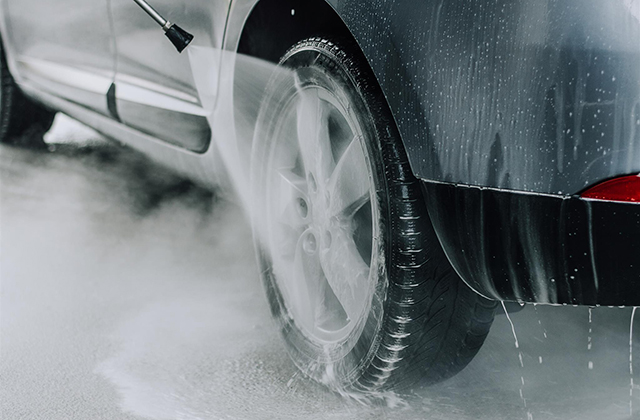Overview
Carnauba wax is so hard that it must be blended with other ingredients in order to make it applicable to paint. One of the many things that I learned the hard way when I first opened my studio was that finishing woodturnings is very different from finishing furniture. Turned wood items demand different finishing protocols, because many of the items that we produce are designed to be used or handled frequently. For example, writing pens and salad bowls vs. coffee tables or chests of drawers. Carnauba wax polish has become one of the most used and popular forms of car wax.
For finishes to succeed on functional woodturnings, they must be able to withstand constant, or frequent handling. This is a very different environment than what furniture is typically exposed to in use. While you probably touch your chest of drawers a couple of times a day getting clothes in and out, you do not hold it in your hands for extended periods of time like you would with a writing pen. The end result of this is that many of the traditional finishes that work well on furniture, may not work as well on woodturnings.
Wax Finishes
One of the most popular finishes for woodturners is wax. It may be used as the sole finish, i.e. Beeswax on a salad bowl, or as a topcoat i.e. Carnauba paste wax over a buffed oil finish. The key to using waxes on woodturnings is to understand the advantages and disadvantages of each wax and then choose the best product to meet your needs. There are many different types of waxes available. However, for this discussion we will limit ourselves to insect waxes like Beeswax, vegetable waxes like Carnauba and Petroleum waxes like Microcrystalline, as these are the most common types of paste wax that woodturners are now using. A quick review of these waxes is in order:
Specific Waxes
Beeswax is a glandular secretion from young worker honeybees that is used to build their honeycomb structures. Contaminants such as pollen, gums and resins add various colors to the wax, which can range from yellow to brown. Used by itself, Beeswax produces a nice, subtle satin luster. It is frequently used as a base ingredient in traditional paste wax finishes.
Carnauba Wax is obtained from the outer waxy coating of palm fronds from the Copernicia cerifera, the Brazilian Carnauba Palm. Carnauba wax is the hardest natural vegetable wax available. It produces a very high gloss and is frequently added to other waxes to increase their melting point, gloss level, durability and lubricity.
Microcrystalline Wax is a petroleum wax containing branched and cyclic saturated hydrocarbons, as well as normal alkanes from deoiled residual bright stock lube oil streams. Microcrystalline waxes have a crystalline structure much smaller than natural waxes and have a very high resistance to moisture, alcohol, acids and fingerprints. Microcrystalline waxes are obtained from the residual fraction of crude oil distillation (Petrolatum) or from crude oil tank bottoms.
Choosing the Right Wax for Woodturnings
Beeswax and Carnauba blended waxes are popular for wood finishing and are produced by numerous manufacturers. Before I opened my studio, I frequently used both types of these waxes on the furniture in my home. Early in my woodturning career, I also used Beeswax and Carnauba for some of my wax finishes, or as topcoats over other finishes. However, I learned very quickly that Beeswax and Carnauba were not always the best choice when used on woodturnings.
Fingerprints, and the occasional summer shower at an art show proved to me that Beeswax and Carnauba looked nice in the studio, but failed quickly in the real world of galleries and art shows. The acidic nature of our fingerprints is very hard on many waxes, because most waxes have very little acid resistance. A quick summer shower at an outside art show, would result in hours of rebuffing finished pieces to get rid of water spots.
As I grew tired of continually rebuffing my work, I fell back on my love of chemistry and started looking for a better quality wax, one that would work in virtually every situation I could throw at it. It would have to stand up to routine handling, resist water spots and fingerprints and keep its luster for a long time. I also wanted a crystal clear wax, one with no chalky residue left behind after buffing. Lastly, my wish list included a wax that was pH neutral, so I didn’t need to worry about the wax damaging the underlying finish, or delicate surfaces. This was a tall order for any wax to achieve, but I knew there had to be something better.
Microwaxes to the Rescue
My searching led me to a wax that was at the time, virtually unknown in the woodturning community – Microcrystalline waxes. Microwaxes have been used for many years by antique restoration businesses, by museums and also by high-end leather manufacturers. Microcrystalline waxes offer the best overall protection for your woodturnings. They offer excellent resistance to moisture, food acids, alcohols, moderate temperatures and are pH neutral naturally. Another benefit is that they will not show fingerprints on treated surfaces. Microwaxes also dry crystal clear, with no chalky residue and resist dust as well. Microwaxes are carried by most of the woodturning stockists now and at many other stores that carry specialty waxes. Microwaxes cost more than traditional waxes, but they last a long time and are useful for many other jobs around your home.
About The Author
Steven Russell is a professional artist, demonstrator and writer. His studio, Eurowood Werks specializes in hand turned bowls, platters and hollow forms with unique visual and tactile treatments. Steve’s website, Woodturning Videos Plus, [http://www.woodturningvideosplus.com] offers educational DVD videos and eBooks for woodturners of all skill levels. To learn more about woodturning, visit his resource library at [http://www.woodturningvideosplus.com/woodturning-education-articles.html] which offers tips and tricks to master the art of woodturning.
In addition to his studio work, Steve frequently writes educational articles for international woodturning magazines, which are published in more than 75 countries around the world. As a highly sought after demonstrator, he has performed more than 1,760 woodturning demonstrations throughout the United States in the last eleven years.
Article Source: http://EzineArticles.com/expert/Steven_Russell/72594
Article Source: http://EzineArticles.com/458674

